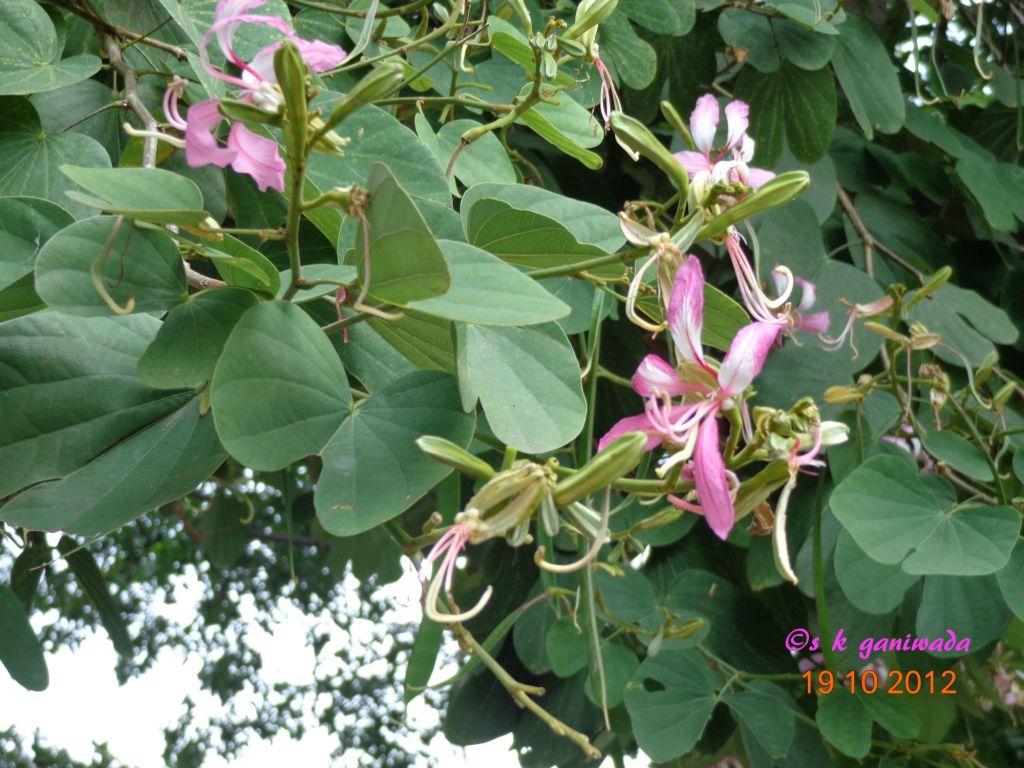Ganesh Chaturthi - Celebration of Flora Fauna as Param
Posted: 29 Aug 2014 17:00
Happy Vinakaya Chaviti to one and all.
The symbolism of Ganesh Chaturthi
Ganesh Chaturthi is celebrated on the day on which Lord Ganesha is believed to bestow his presence on earth for all his devotees. Ganesha, the elephant-headed son of Shiva and Parvati, is worshipped as the supreme god of wisdom, prosperity and good fortune. Though it is celebrated as the birthday of Lord Ganesha [Images], the symbolism behind the festival is much deeper.
The essence of Ganeshji is brought out beautifully by Adi Shankara. Though Ganeshji is worshiped as the the elephant-headed God, the form (swaroop) is just to bring out its parabrahma roopa. Ganeshji is described as Ajam Nirvikalpam Niraakaaramekam. This means that Ganeshji is never born.
He is Ajam (unborn), he is Niraakaar (formless) and he is Nirvikalpa (attributeless). Ganeshji symbolises the consciousness which is omnipresent. Ganeshji is the same energy which is the reason for this universe, from which everything is manifested and it's the same energy in which the whole world will be dissolved. Ganeshji is not somewhere outside of us, but the very centre of our life. But this is very subtle knowledge. Not everybody can perceive the formless without the form. Our ancient Rishis and Munis knew this; so they created the form for the benefit and understanding of people at all levels. Those who can't experience of the formless, over a period of sustained experience of manifested form reach the formless Brahman.
So in reality, Ganeshji is formless; yet there is a form to which Adi Shankara prayed and that form carries the message of the formlesness of Ganeshji. Thus, the form serves as the starting point and gradually the formless consciousness begins to manifest. Ganesh Chaturthi marks a unique art of reaching formless Paramatma called Lord Ganesh by repeated worship of the manifest form of Ganesha. Even the Ganesh Stotram, the prayers recited in the praise of Ganeshji, conveys the same. We pray to Ganeshji in our consciousness to come out and sit in the idol for us for a while so that we can play with him. And after the puja, we again pray asking him to go back to where he comes from; that's our consciousness. While he is in the idol, we offer back whatever God has given us through the puja of the idol.
The ritual of immersing (visaran) the idols after few days of worship reinforces the understanding that God is not in the idol, it's inside us. So experiencing the omnipresent in the form and deriving joy out of the form is the essence of the Ganesha Chaturthi festival. In a way such organised festivity and worships lead to an upsurge in enthusiasm and devotion.
Ganeshji is the lord of all the good qualities in us. So when we worship him, all the good qualities will blossom in us. He is also the lord of knowledge and wisdom. Knowledge dawns only when we become aware of the Self. When there is inertia, there is no knowledge, no wisdom, nor is there any liveliness (Chaitanya) or progress in life. So the consciousness has to be awakened and the presiding diety of consciousness is Ganeshji. That's why before every puja, the Lord Ganesha is worshiped to awaken the consciousness.
Therefore, install the idol, worship it with infinite love, meditate and experience Lord Ganesha from within. This is the symbolic essence of Ganesh Chaturti festival, to awaken the Ganesha tatva which is masked inside us
21 Types of Patra-Patri used in Ganesha Chaturthi-Vinayaka Chavithi puja
Sanskrit Name Machi Patram
Telugu Name Machipatri (Davanam)
Mantra Sumukhaya Namaha
Botanical Name Artemisia vulgaris/Imperata Cylindrica
Medicinal Use used for curing skin diseases (leprosy, leucoderma), nervous diseases, and abdominal related
Sanskrit Name Brihathi Patram
Telugu Name Vaakudaaku
Mantra Ganadhipaya Namaha
Botanical Name Solanum indicum/Carisssa Carandass
Medicinal Use Used for asthma, cough, constipation. Also used for women in post natal period
Sanskrit Name Bilva patram
Telugu Name Maaredu
Mantra Gowriputraya Namaha
Botanical Name Aegle marmeolus
Medicinal Use Used for Dysentery. It also purifies water. Bilva leaf is very popular in the worship of Lord Shiva
Sanskrit Name Durvara Patram
Telugu Name Garika
Mantra Gajananaya Namaha
Botanical Name Cyanodon dactylon/Cyanodon Dacry
Medicinal Use used for Skin diseases, arresting bleeding, anemia. Durva leaf is used in the worship of Lord Ganesha
Sanskrit Name Dattura Patram
Telugu Name Ummetta
Mantra Harasunve Namaha
Botanical Name Stramonium
Medicinal Use Used for joint pains, abdominal, skin diseases, hair fall. Also used in poisonous bites
Sanskrit Name Badari patram
Telugu Name Regu
Mantra Lambodaraya Namaha
Botanical Name Zizyphus mauritiana/ Z.jujba
Medicinal Use Used for digestive disorders, wounds and injuries, blood impurities. Also used for maintaining the voice.
Sanskrit Name Apamarga Patram
Telugu Name Uttareni
Mantra Guhagrajaya Namaha
Botanical Name Achyranthus Aspera
Medicinal Use Used for digestive disorders and also used for poisonous bites.
Sanskrit Name Tulasi patram
Telugu Name Tulasi
Mantra Gajakarnaya Namaha
Botanical Name Ocimum sanctum
Medicinal Use Used for respiratory diseases, skin diseases, purifies air, water and surroundings. The leaves are used in the worship of Lord Vishnu who is very much fond of Thulasi
Sanskrit Name Choota Patram
Telugu Name Mamidaaku
Mantra Ekadantaya Namaha
Botanical Name Azadarcata indica/ Mangifera indica
Medicinal Use Used in Diabetics, for cracked heals, diseases of throat.
http://www.yadtek.com/wp-content/upload ... 230613.jpg
Sanskrit Name Karaveera Patram
Telugu Name Ganneru
Mantra Vikataya Namaha
Botanical Name Thevetia Nerifolium/Nerium indicum
Medicinal Use Used for leprosy, wounds and injuries, hair fall, lice.
Sanskrit Name Vishnu Kranta Patram
Telugu Name Vishnukanta
Mantra Bhinnadantaya Namaha
Botanical Name Evolvulus Aisinoides/Convolvulus pluricaucis
Medicinal Use Used for Nervous related, memory power
Sanskrit Name Daadimee Patram
Telugu Name Danimma
Mantra Vatave Namaha
Botanical Name Punica granatum
Medicinal Use Used for Dysentery, Vata/Pitta/Kapha dosha
Sanskrit Name Devadaaru Patram
Telugu Name Devadaaru
Mantra Sarveswaraya Namaha
Botanical Name Cedrus deodar
Medicinal Use Used for skin diseases, wounds/injuries
Sanskrit Name Maruvaka patram
Telugu Name Maruvam
Mantra Sureswaraya Namaha
Botanical Name Cedrus deodar
Medicinal Use Used for Joint pains, skin diseases, heart diseases
Sanskrit Name Sindhuvara Patram
Telugu Name Vavili
Mantra Herambhaya Namaha
Botanical Name Vitex nirgundo
Medicinal Use Used for Vaata related problems and also used in anti poisonous drugs.
Sanskrit Name Jaji Patram
Telugu Name Jaji
Mantra Surpakarnaya Namaha
Botanical Name Jasminum grandiflorum/Myristica Fragrams
Medicinal Use Used for skin diseases, Mouth related problems and also in indigestion.
Sanskrit Name Gandaki Patram
Telugu Name Devakanchanam
Mantra
Botanical Name Sterculia Urens/Latha Durva
Medicinal Use Used for Heart related, Piles, Skin diseases.
Sanskrit Name Shami Patram
Telugu Name Jammi Aaku
Mantra Ibhavaktraya Namaha
Botanical Name Prosopis specigera
Medicinal Use It is used for respiratory problems. This tree is also worshipped as a remedy and we find people taking pradakshina around this tree on the day of Vijaya Dasami.
Sanskrit Name Aswatha Patram
Telugu Name Raavi Aaku
Mantra Vinayakaya Namaha
Botanical Name Ficus religiosa
Medicinal Use Its bark is used in preparation of many medicines. It is also used for arresting bleeding. The significance and importance of this tree is so much that it is considered as Trimurthi (Trinity) swaroopa (Trinal Lords, Brahma, Vishnu and Shiva). We find people performing Naga Devatha Pratishta under this tree.
Sanskrit Name Arjuna Patram
Telugu Name Tella Maddi
Mantra Surasevitaya Namaha
Botanical Name Morinda Tinctoria/Terminelia Arjuna
Medicinal Use Used for Joint pains, Vata/Pitta/Kapha related, heart diseases, wounds and septic conditions.
Sanskrit Name Arka Patram
Telugu Name Jilledu
Mantra Kapilaya Namaha
Botanical Name Calotropis Procera
Medicinal Use It is used in poisonous bites, wounds and injuries, curing skin diseases, leprosy, tumors, joint pains, etc… It is said that it has 64 varieties of medicinal usage. It is called as a healing herb. We find usage of this leaf on the day of Ratha Sapthami. It is associated with the worship of Sun God, Lord Hanuman and also Lord Ganesha.























